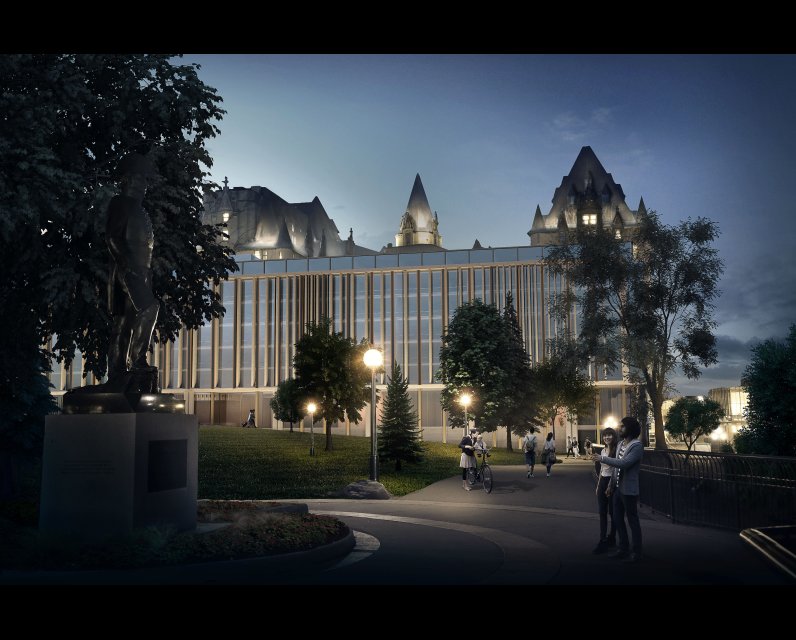Unpublished Opinions
Mr. Waldron is a heritage conservation manager for a leading facilities and project management company in Canada. He has been a Parks Canada Superintendent, the Canadian Registrar of Historic Places and manager of the Federal Heritage Buildings Review Office. As an architectural historian, he specialises in Canadian modernism. He has been president of the Society for the Study of Architecture in Canada, is author of Exploring the Capital: An Architectural Guide to the Ottawa-Gatineau Region and is an adjunct professor at Carleton University in the History and Theory of Architecture
When Architecture Fails to Speak for Itself: The Château Laurier addition.

Imagine it is 2030 and over the past decade the Château Laurier addition has been derided not only for its misunderstanding of architecture, but for the City’s poor decision to allow this decorated box to be constructed. In 2030, visitors to the Capital are surprised that a generic rectangular box, clearly struggling to relate to the Picturesque Château, was ever built. They will ask: isn’t it a National Historic Site? Weren’t there strict controls? Didn’t it hold a symbolism and meaning that is part of the City’s identity that should be better respected?
This future cannot be: an outside architect, who does not fully appreciate context, produces a weak design that is built because we lack awareness of our own architectural identity.
Downtown Ottawa is composed of four quadrants: a federal precinct (north of Wellington and Mackenzie), a business core (south of Wellington), a former transportation hub (east of Sussex Drive) and a people’s market (the Byward Market). Each quadrant holds its own architectural expression. The federal quadrant is revivalist, with nationalist and historicist meanings that the original architects of the Château Laurier understood. The office towers of the central business core offer another expression – more functional and less inspired by an aesthetic approach to architecture. The Union Station, the Canal and the driveways are transport routes and buildings for the core. The Byward Market is a human-scaled pedestrian zone.
What architectsAlliance and their conservation architects, ERA Architects, are proposing is the insertion of a functional, albeit now partially dressed, decorated box into the historicist precinct. They resist and ignore the conceptual and architectural language of this space.
As version has followed version, it has become abundantly clear that the architects do not understand the place. They are misguided in understanding the identity of Ottawa and its relationship to landscape and the spectacle of this romanticized space.
Good architecture speaks for itself. It is not defended for years by the designer. Good architecture may be challenging, radical and exciting, but that is not the story of this addition. It is a story of a resistant architect, and by consequence a resistant owner, neither of whom can see the values of the Chateau Laurier.
Peter Clewes insists he is not interested in being popular (although his communication team released to the media that 70% of respondents support the latest design), and he considers Ottawa to be “fearful of change” and “skeptical of change” (“Château Laurier architect defends modernist addition,” CBC, June 11, 2018). Actually, it is not that change is feared, but that we do not want poor change – also known as a mistake.
Rationalizing beauty is always a red flag, and this is what the architects are desperately trying to do after unveiling their fourth version of the design. Not only is the work now truly a decorated box, there is a paucity of beauty.
Both Peter Clewes and Michael McLelland have at expert committees and City-controlled public consultations, explained their design as a modernist interpretation of the Picturesque and associational values of the Château Laurier. They have used poor examples (including the Louvre addition, Foster’s Reichstag and the urbanist addition to the Glasgow School of Art) as justifications for their decorated box. But all miss the fundamental flaws of their design: its lack of symbolic language; its massing relationship; its intellectual language; its ethical expression.
The debate over the design is not one of ancients versus moderns – as Clewes (who is ‘award-winning’ – what architectural firm is not these days?) and their team have tried to frame the debate. It is, in fact, a debate about poetry and ethical poesis (or the ethics of creating). The morality and ethics of the architects’ imagination in understanding the cultural expression of early 20th century Canada, in all its complexity, is what should drive the design of the addition to the Chateau Laurier.
Instead, what we have is an architect who is wishing to defend his design within a simplistic framework of modernist-versus-postmodernist world. Meaning, Clewes’ modernism is a counterpoint to the aesthetic superficiality of post-modern designs (or a 20th-century historicism that he likely abhorred in the 1980s). His argument does not truly respond to the public debate. The real debate is about the ethics of architecture and why the wealthy owners cannot resolve to listen to public and professional opinion on what is most appropriate for an addition.
Clewes’ arguments for defending the design morphed as each iteration of the design was unveiled. His arguments have included: positioning the addition as contemporary while also respecting the Château Laurier’s heritage; that the addition is not an addition to the Château, but an object now related to the urban landscape of the park; that the glass block is a silhouette or shadow – or even the opposite, a “luminous palette” that does not compete or “overwhelm the heritage features” of the Château. A confident intelligent design does not constantly shift in justification to suit taste and fashion, whether it be for the general public or for the approval process.
Earlier attempts at the addition were intended to be an abstraction of the Château’s architecture. Now, in the latest design, we have an abstraction that has lost its essence due to Clewes and his team’s desperate search for material ornament to appease those critical of the design (more specifically, the City of Ottawa’s Urban Design Review Panel). I suspect they will ultimately succeed since the City’s planning department will capitulate to almost any powerful landowner.
Obviously, architecture is experienced in different ways than an artwork, but the concept of a work that is an object of beauty can be achieved. Additions are challenging, especially when the previous addition, (designed in 1928 by John S. Archibald with John Schofield) was a subtle, distinguishable wing that was praised and that the public enjoyed when unveiled. It used ornament to extend the language of the original building. Indeed, when the original owners were not satisfied with the first version of the Château Laurier in 1908, they fired the architect!
An example recently sent to me was the insertion by Ptolemy Dean Architects at Westminster Abbey. An internal stair would have damaged the building’s historic fabric. In response, the Gothic abbey opted to create an external staircase to access the exhibition rooms. Though a small insertion to the site, the “steampunk” Neo-Gothic element is contemporary as well as historicist. It certainly would comply with the Standard 11 of the Standard & Guidelines.
At this exasperating stage of the process, I would even entertain out of desperation a reproduction as an option (see Robert Stern’s Pauli Murray & Benjamin Franklin College, Yale University, 2017).
Design can be symbolic and express its function. Clewes’ design is now frantically adding decoration – not ornament, in hopes of finally acquiring that precious building permit. This version of the addition still does not express the symbolism that is the Chateau Laurier. It is why it continues to fail as an addition and should not be built.
The Château Laurier may be in private hands, but there is a public function to the building that must be understood in this debate. For a building type – the grand railway hotel – it is young, only a little more than a century old. But the significance of its expression is as equal to the cathedral-like qualities of the Parliament buildings.
Attempts to build decorated boxes within the Parliamentary precinct have been proposed before. Can this neo-modernist box, now fully decorated and facing Majors Hill Park, become part of the narrative of our identity? I doubt it.
In 2030, some of us will pine for the Château Laurier’s dignified qualities before the addition. We will be embarrassed to tell a younger generation of the addition’s failure to incite excitement and create a sense of place. We will need to explain to our visitors why it was a mistake. We will explain who the architects were and how Council at the time decided to allow this to happen, without understanding its design flaws.
On the other hand, there is an election this year and perhaps Council will wish not to be remembered for a poor decision with major consequences for us all.
The preferred option of an open, transparent, national competition, with public engagement which would lead to citizens embracing Larco’s participatory vision for one of their most beloved landmarks, could still occur if they simply halted this process.



Comments
Be the first to comment